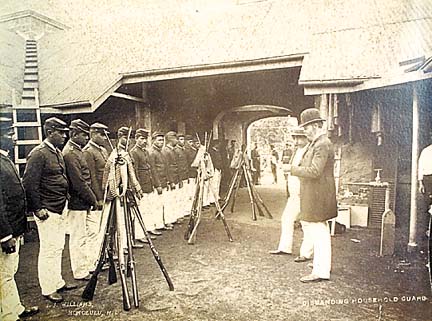


Amid rallies and U.S. troops
Star-Bulletin
coming ashore, Liliuokalani
yields the throneOn Jan. 17, 1893, as night fell across the Hawaiian Islands, Queen Liliuokalani wrote in surrender:
"By the Grace of God and under the Constitution of the Kingdom, (I), do hereby solemnly protest against any and all acts done against myself and the constitutional government of the Hawaiian Kingdom, certain persons claiming to have established a provisional government of and for this Kingdom."
Two years earlier, Liliuokalani had inherited a waning monarchy: Hawaiian royalists were dwindling, while new players were envisioning fertile economies in Hawaii's fields.
The Mahele of 1848 had revolutionized land ownership, giving commoners -- but more crucially, foreigners -- the right to own. In July 1887, a coup by the white businessmen's Hawaiian League forced then-King Kalakaua to sign the "Bayonet Constitution," which stripped the monarchy's powers. An 1889 rebellion led by crown loyalist Robert Wilcox failed to overturn that Constitution.
The power plays came to a head in 1893.
Jan. 14, in particular, was feverish: Liliuokalani telling her Cabinet at 10 a.m. she would proclaim a new constitution that afternoon; the USS Boston returning to Honolulu Harbor at noon from an exercise off Hilo; annexationists in early afternoon calling Liliuokalani guilty of treason for trying to issue a new Constitution, which ultimately never came; annexationists at night recruiting armed supporters.
Then came Jan. 16.

The queen and her supporters gathered at Iolani Palace to discuss the collapsing monarchy. Around town, rallies were held, for and against her.At the Armory, the present site of the state Kalanimoku Building at Punchbowl and Beretania streets, rallied 1,500 members of the pro-annexation Committee of Public Safety. At that same time, 162 sailors and Marines from the USS Boston came ashore and marched through downtown Honolulu.
The monarchy, which had lasted one hundred years, was lost the next day.
Liliuokalani hoped the United States would restore the monarchy. But despite a report from James Blount, U.S. Special Commissioner to Hawaii, arguing that U.S. Minister James Stevens and island businesses had conspired to overthrow the monarchy, nothing changed.
Coming to power on Jan. 17 were anti-royalists who, though espousing American justice and civil liberties, immediately declared martial law.
Their leader was Lorrin Thurston, who had formed the semi-secret Hawaiian League, written the Bayonet Constitution, forced his Cabinet on King Kalakaua, and represented the new government before the federal powers in Washington, D.C.
He also was a grandson of the missionaries who had counseled and converted Queen Kaahumanu. "These were the men who built up the country commercially, agriculturally, financially, and politically," he said of the missionary descendants. "Who could ask for men more qualified to decide the fate of the country than those educated and responsible citizens of Hawaii?"
It was Liliuokalani, however, who with great dignity, argued that the kingdom was lost to people "who insisted upon hiding their notices under the guise of friendship for the Hawaiian people.
"They point to the noble causes of liberty and freedom," she wrote. "Yet they refuse to grant this liberty and freedom to the Hawaiian people."
The Honolulu Star-Bulletin is counting down to year 2000 with this special series. Each month through December, we'll chronicle important eras in Hawaii's history, featuring a timeline of that particular period. Next month's installment: July 12. About this Series
Series Archive
Project Editor: Lucy Young-Oda
Chief Photographer: Dean Sensui